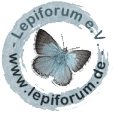

 +1Kontinente:SA
+1Kontinente:SA2. Weitere Informationen
2.1. Taxonomie und Faunistik
Der Name der neuen Art soll die nahe Verwandtschaft zu E. perniciosus ausdrücken. Locus typicus nach Zhang et al. (2015: 78): Brasilien: "Brazil: São Paulo, Casa Branca". Sie ergänzen zur Gesamtverbreitung: "Currently known only from the holotype collected in Southeast Brazil."
2.2. Typenmaterial
Die Art wurde nach einem Einzelexemplar beschrieben. Zhang et al. (2015: 78) teilen mit: "Holotype: ♂ deposited in the Museum für Naturkunde, Berlin, Germany (MFNB), illustrated in Fig. 184–185 (genitalia Fig. 884–885), bears the following five rectangular labels (1st handwritten, others printed), four white: [ Cas. Bra. | G. ], [ DNA sample ID: | NVG-21126E08 | c/o Nick V. Grishin ], [ DNA sample ID: | NVG-23081B01 | c/o Nick V. Grishin ], [ genitalia | NVG240912-09 | c/o Nick V. Grishin ], and one red [ HOLOTYPE ♂ | Ectomis (Ectomis) | pernicioides Grishin ]. The first DNA sample ID refers to the extraction from a leg (sequenced), and the second from the abdomen (stored) prior to genitalia dissection."
2.3. Literatur
- Erstbeschreibung: Zhang, J., Cong, Q., Shen, J., Song, L. & N.V. Grishin (2025): Descriptions of three hundred new species of Hesperiidae (Lepidoptera: Papilionoidea). — Insecta Mundi, 1148: 1–369. doi.org/10.64338/im.1148.2704t. [zur open-access-Arbeit mit PDF-Download]



